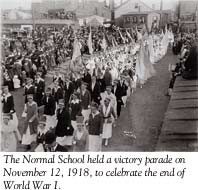World War I
When World War I broke upon the U.S., ninety-seven
men and women, graduates and former students of
the Normal and Model Schools reported for National
Service. Men students disappeared almost entirely,
and at one time during the war a low of two was
reached. The men's dormitory was remodeled to house
fifty women in 1921. When the war ended, the men
began to return, and by June 1923 male enrollment
had grown to forty-one.
During this time, victory gardens were planted and
cultivated by faculty, staff, and sixty students,
helping to increase the amount of food exported.
Students in the Domestic Arts Department knitted
240 sweaters to be sent to Camp Dix, and made helmets
and socks for Camp Meade.
Perhaps the most exciting event during that time,
however, was November 11-15, 1918, officially hailed
as Peace Day Celebration. The four-day event consisted
of parades, bonfires, buffets, and best of all-no
classes.
World War II
 When
America entered World War II in 1941, male students
were again called to perform their duty. The Class
of 1943, under the Roscoe West administration, planted
a tree to "all the boys in the class who have
left for the various branches of the service." When
America entered World War II in 1941, male students
were again called to perform their duty. The Class
of 1943, under the Roscoe West administration, planted
a tree to "all the boys in the class who have
left for the various branches of the service."
At one time during World War II, as few as eighteen
men remained on the campus. Six hundred and three
students and alumni went into the service and thirteen
did not return.
To enable male students to finish as much work as
possible before being called up, and to meet the
shortage of teachers resulting from the war, an
accelerated program was begun in the summer of 1942.
This was continued throughout the summer of 1945,
but ended as veterans began to return to The College.
Social Life
Social life on the campus also changed during World
War II and activities related to the war were introduced.
The War Service Committee of The College handled
nearly $1,100 allotted to it by the Student Executive
Committee and earned through programs and sales.
Major disbursements were for equipment of a day
room at Fort Dix, the World Student Service Fund,
expenses of a party for soldiers, and transportation
for women students to dances at Fort Dix.
Other groups went to entertain in Trenton Service
Areas. Hundreds of Christmas presents were assembled
and wrapped for the Army. A college unit of the
Trenton Chapter of the American Red Cross was set
up, under which a nurse's aide course and a standard
nutrition course for work in the canteen corps were
sponsored.
During the summer of 1943 The College contributed
to the food supply by making land available for
twenty-five victory gardens cultivated by members
of The College faculty and staff. Cooperative planting,
cultivating, and harvesting of an area of beans
and tomatoes were carried on by students and faculty.
|
|
|


